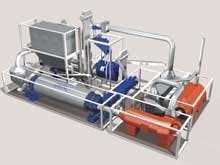Search for efficiency reaps safety benefits
By Ivar Madsen, Sipke Verbeek
The European Committee for Standardisation are now finalising details in the European Union (EU) Directive 94/9/EC, commonly known as ATEX, that lays down the overall safety standards and determines the specifications with which all new sludge drying installation must comply. The EU Directive - Equipment and protective systems intended for use in potentially explosive atmospheres - will take effect on 1 July 2003.
Several factors have driven up the demand for sludge drying in recent years - sludge disposal legislation, rising disposal costs, closing of traditional disposal routes, and the increase in sludge generation from improved wastewater treatment. However, concerns about the dangers associated with the combination of sludge dust, oxygen levels and high product temperature have inhibited the practical implementation of sludge drying facilities. Additionally, varying legislative requirements within European member states have also hindered the construction of sludge drying facilities. The ATEX directive will change this situation.
The ATEX directive divides potential risk into three groups:
• To prevent the formation of explosive atmospheres produced or released by the processing system and by the protective systems themselves;
• To prevent the ignition of explosive atmospheres;
• Should an explosion occur, to halt it immediately and/or limit the consequences.
The risk of fire and explosion generally depends on the presence of three factors: temperature, material (dust) and oxygen (See Fire Triangle). In regards to sludge drying systems, this translates into the following specific conditions worthy of special concern and attention:
• Large volumes of air-suspended dust particles at a concentration of 20-60 g/Nm3;
• Dust particle size < 500 micron;
• An energy source - which can be either a hot spot with temperatures reaching from 400-500°C, or the presence of sparks;
• Dry air with an oxygen content of >11%.
All sludge systems today have measures to prevent the occurrence of such situations and to deal with them once they have arisen; the question is how well it is done, and at what cost.
The Netherlands' Vandenbroek International and Alfa Laval of Denmark approached the ATEX challenge by developing the ALDRY sludge dryer, following the signing of a strategic alliance between the two companies in early 2002. The ALDRY process is based upon proven technology used by Vandenbroek for decades in the United Kingdom, which enforces very strict regulations in this particular area. Rik Janssen, process engineer at Vandenbroek, explained:, "When we were working on developing the ALDRY idea, we were looking for ways to integrate the odour control with the drying process itself, in order to regenerate heat from the odour treatment. This process gave us energy savings of 10-15%. We also succeeded in limiting the oxygen level in the potentially dangerous zones of the dryer."
The "non-saturated" drying principle is important because low oxygen content is a major breakthrough. In most systems, provision must be made for suppressing explosion risks associated with significantly higher levels of oxygen present inside the installation. In practice, the oxygen level in ALDRY does not exceed the limit for dust environments. At nominal load, this level amounts to less than 4.5%.
The ALDRY also works with a low product temperature - a unique property for the market. The temperature is always kept below 80°C to 85°C, because the ALDRY rotating drum works on the basis of the non-saturated drying principle. A full stream condenser removes the majority of water. This is in marked contrast to other systems that are not fitted with such a condenser. These systems require a high outlet temperature to prevent the air from becoming liquefied. This, in turn, results in a higher product temperature (130-140°C) within the drying process. Two of the three factors in the fire triangle are still present in these systems. The ALDRY process removes all three factors that can cause explosions while reducing costs and simplifying the cooling process.
In the UK, strict requirements regarding sludge drying (HSE 847/9) motivated Alfa Laval to develop the "Dual Protection Package," which enables facilities to meet even the strictest future regulations regarding fire and explosion risks - not only in Europe but in the rest of the world.
Authors' noteIvar Madsen, the Business Manager-Dryers of Alfa Laval, is based in Copenhagen, Denmark. Account Manager Sipke Verbeek of Vandenbroek International is located in Driebergen, The Netherlands.


